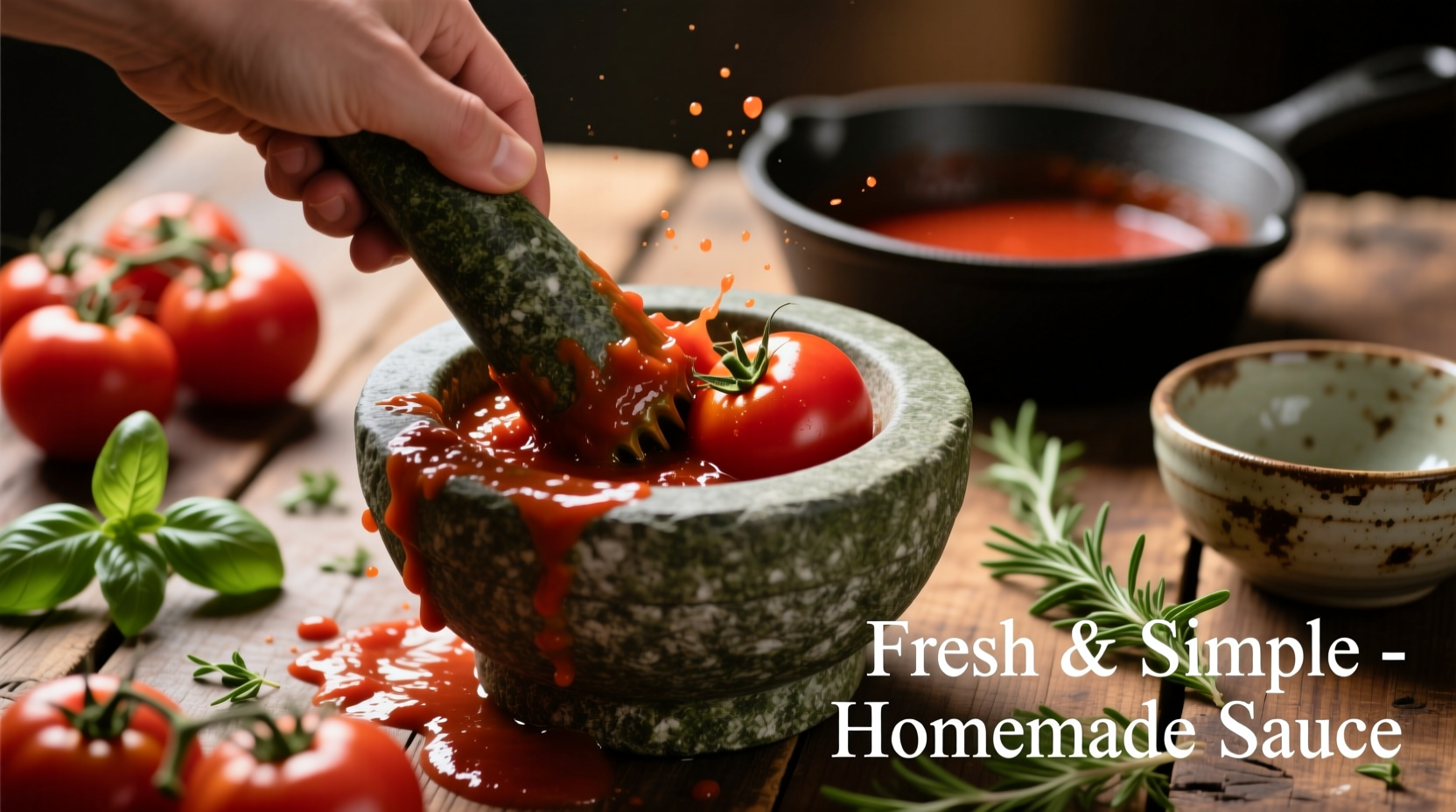Learn how to make rich, flavorful tomato sauce from fresh tomatoes in just 6 steps. This authentic method yields 4 cups of vibrant sauce with no artificial additives, perfect for pasta, pizza, or freezing. You'll need only 5 basic ingredients and 2 hours (mostly hands-off) to create restaurant-quality sauce that preserves summer's freshness year-round.
There's nothing quite like the taste of homemade tomato sauce made from vine-ripened produce. While store-bought versions offer convenience, they often contain preservatives and lack the bright, complex flavor of fresh tomatoes transformed through proper technique. As a chef who's worked with tomatoes across Italy's growing regions, I've refined this method to maximize flavor while minimizing effort.
Why Fresh Tomatoes Make Superior Sauce
Commercial sauces frequently use underripe tomatoes harvested early for shipping durability, then artificially ripened. This compromises flavor development. According to USDA agricultural research, vine-ripened tomatoes contain 30% more lycopene and develop more complex sugar-acid balances essential for rich sauce. The difference becomes especially apparent when you taste sauce made from garden-fresh Roma or San Marzano varieties.
| Tomato Variety | Best For | Flavor Profile | Seeds/Skin Removal Needed |
|---|---|---|---|
| Roma (Plum) | Classic Italian sauce | Balanced sweetness, low moisture | Skin only |
| San Marzano | Neapolitan-style sauces | Sweet with low acidity | Skin only |
| Beefsteak | Chunky vegetable sauces | Bright, acidic | Skin and seeds |
| Cherry | Quick fresh sauces | Intensely sweet | None |
Gathering Your Ingredients and Equipment
Quality ingredients form the foundation of exceptional sauce. For the best results when you make tomato sauce from fresh tomatoes, select:
- Tomatoes: 5 pounds ripe Roma or San Marzano (about 12-15 medium)
- Aromatics: 1 large yellow onion, 4 garlic cloves
- Herbs: 1/4 cup fresh basil, 2 sprigs fresh oregano
- Acid: 2 tbsp lemon juice or red wine vinegar
- Seasoning: 2 tsp sea salt, freshly ground black pepper
Essential equipment includes a heavy-bottomed pot (prevents scorching), sharp knife, cutting board, immersion blender, and food mill or fine-mesh strainer. The food mill proves particularly valuable when you make tomato sauce from fresh tomatoes as it efficiently separates seeds and skins while preserving texture.

Step-by-Step Sauce Preparation
Follow this professional technique to transform fresh tomatoes into exceptional sauce:
1. Prepare the Tomatoes
Score an "X" on the bottom of each tomato. Blanch in boiling water for 30 seconds, then transfer to ice water. The skins will peel away easily. This critical step when you make tomato sauce from fresh tomatoes ensures smooth texture without bitter skin flavors.
2. Sauté Aromatics
Heat 3 tbsp olive oil over medium heat. Add finely diced onion and cook until translucent (8 minutes). Add minced garlic and cook 1 minute until fragrant but not browned. Properly cooked aromatics form the flavor foundation.
3. Simmer the Tomatoes
Add peeled tomatoes, lemon juice, salt, and herbs. Bring to a gentle simmer (do not boil vigorously). Partially cover and cook for 45-60 minutes, stirring occasionally. The sauce is ready when it coats the back of a spoon.
4. Refine the Texture
Remove herb sprigs. For smooth sauce, pass through a food mill. For rustic texture, use an immersion blender directly in the pot. This stage determines your final sauce consistency when you make tomato sauce from fresh tomatoes.
5. Final Reduction
Return sauce to low heat uncovered. Continue simmering 15-20 minutes to concentrate flavors. Stir frequently to prevent sticking. Proper reduction creates that signature rich, clinging texture.
6. Acid Balance Check
Taste and adjust: add lemon juice for brightness if needed, or a pinch of sugar if tomatoes were particularly acidic. This final adjustment makes all the difference in professional-quality sauce.
Preservation Methods and Safety Guidelines
According to National Center for Home Food Preservation, proper acidification is critical when preserving tomato products. Always add lemon juice or citric acid to ensure pH below 4.6 for safe canning. Never attempt water bath canning without proper acidification, as low-acid tomatoes can support botulism growth.
For refrigerator storage: cool sauce quickly in an ice bath, then store in airtight containers for up to 5 days. For freezing: portion into 1-cup containers (ideal for single pasta servings) and freeze up to 12 months. Frozen sauce maintains flavor better than canned for fresh tomato preparations.
Troubleshooting Common Sauce Problems
Even experienced cooks encounter issues when they make tomato sauce from fresh tomatoes. Here's how to fix them:
- Too watery: Continue simmering uncovered to reduce. A cornstarch slurry (1 tsp cornstarch + 1 tbsp cold water) can thicken quickly if needed immediately.
- Too acidic: Add 1/4 tsp baking soda (neutralizes acid) or 1 tsp honey. Balance with umami-rich ingredients like sautéed mushrooms.
- Bitter flavor: Usually from overcooked garlic or tomato skins. Next time, add garlic later in cooking and ensure complete skin removal.
- Flat flavor: Boost with 1 tsp fish sauce (adds umami without fishiness) or a Parmesan rind during simmering.
Flavor Variations to Explore
Once you've mastered the basic technique for how to make tomato sauce from fresh tomatoes, experiment with these professional variations:
- Arrabbiata: Add 1/4 cup chopped Calabrian chilies with aromatics
- Vodka Sauce: Stir in 1/2 cup vodka after tomatoes have reduced by half
- Puttanesca: Mix in 2 tbsp capers, 1/4 cup olives, and 4 anchovy fillets
- Rustic Vegetable: Add 1 diced carrot and celery stalk with onions
Why This Method Works
Professional chefs consistently achieve better results when they make tomato sauce from fresh tomatoes by controlling three critical factors: acid balance, reduction level, and cooking temperature. The blanching technique preserves fresh flavor while removing skins that would impart bitterness. The slow reduction develops complex flavor compounds through the Maillard reaction without scorching. And the final acid adjustment creates the bright, balanced profile that defines exceptional sauce.











 浙公网安备
33010002000092号
浙公网安备
33010002000092号 浙B2-20120091-4
浙B2-20120091-4